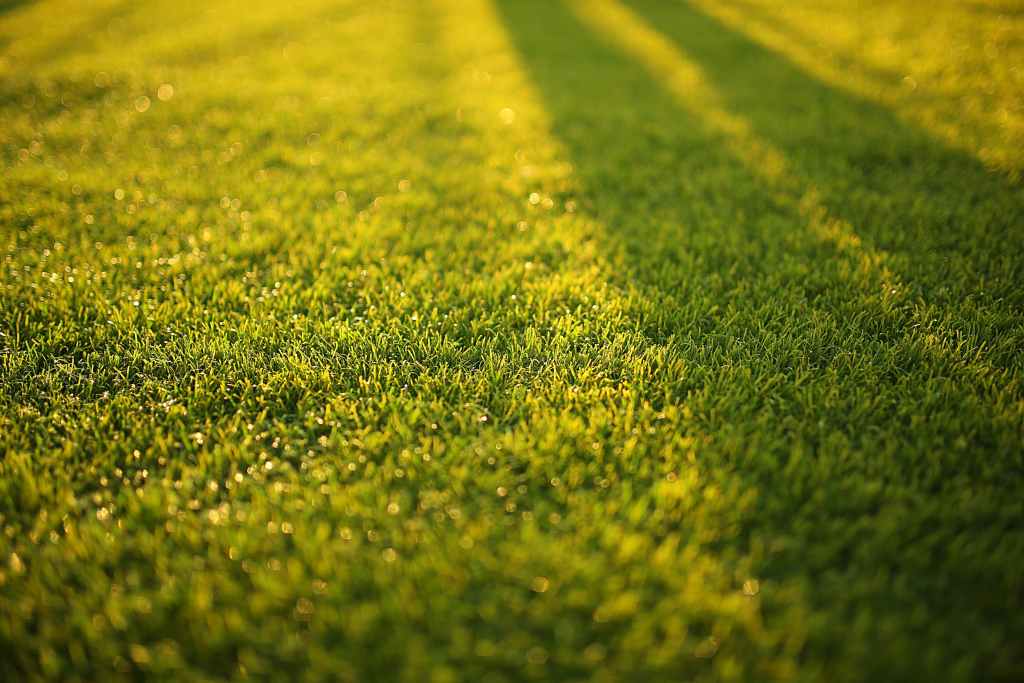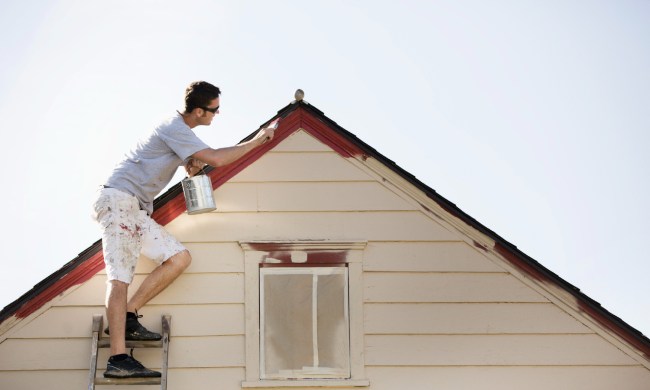
Grass needs water to thrive, but it may be difficult or impossible to give your lawn the amount of moisture it needs during a drought. Here are some tips on how to help your lawn survive when water is scarce.
- Recognize signs your lawn is stressed and don’t make things worse
- Water your lawn the right way
- Use sprinklers appropriately
- Don’t waste water
- Cut the grass higher than usual
- Think carefully about letting your lawn go dormant
- Consider using a product to help your grass retain moisture
- Care for your lawn when conditions are good
Recognize signs your lawn is stressed and don’t make things worse
Homeowners often make mistakes because they don’t realize that their grass is stressed. Be on the lookout for grass that is wilting or becoming a darker color than usual.
According to Carl Clifton, owner of Lawnscape Systems in California, homeowners often don’t recognize brown grass as a sign that the grass is stressed due to insufficient water. “It’s amazing how many people look at browning and don’t think water at first,” he said.
Instead, many homeowners mistakenly believe that the problem is due to fungus or insects. According to Clifton, with “80% of browning in most people’s lawns, it’s going to be water. 20% of the time, it’s insects or fungus.”
So what should you do if your lawn is stressed?
- Avoid walking on the grass as much as possible. Take a look at your lawn if you walk across it. If you notice “… footprints that don’t spring right back after you walk across it,” that’s a sign that your lawn is stressed, according to Clifton.
- Monitor your lawn and remove weeds or treat them with an herbicide as soon as possible. Grass that is stressed is more vulnerable to weeds. They can use vital nutrients that your lawn needs to survive a drought.
- If your grass is stressed due to a lack of rainfall, some things that you might do to try to help it could actually make things worse. If your lawn has a thick layer of thatch, removing it can help the grass get vital moisture, but getting rid of too much thatch at one time can further damage a lawn that’s already stressed. You should also avoid aerating and fertilizing during a drought.

Water your lawn the right way
Many homeowners don’t know the proper way to water their grass. Giving your lawn a little water each day is ineffective since the moisture won’t sink deep into the soil.
Grass needs to be watered infrequently and given a good soaking so that moisture can get down deep into the ground. That encourages the grass to form deep roots, which can make it stronger and better able to survive adverse conditions.
“Water infrequently and deep,” Clifton advised. “This runs contrary to an awful lot of things that happen now… Deep roots will sustain grass through a drought better.”
According to Clifton, the best practice is to water two to three times per week for 20 or 30 minutes.
Tom Taylor, owner of Lawn Doctor in North San Diego County, California, agreed. “We find most people don’t water enough, and they water too often,” he explained. “This [watering deeply and infrequently] is what allows the grass to go longer without watering.”
It’s also important to water at the right time. If you water during the day, when the sun is bright and hot, moisture will evaporate quickly instead of soaking deep into the soil. If you water in the evening, the lawn can remain damp overnight, which can increase the risk of fungus growing on the grass.
Watering your lawn early in the morning is ideal. If you can’t do it yourself, you can use sprinklers and program them to give the lawn a thorough watering early in the day.
Use sprinklers appropriately
According to Taylor, “The most important thing is irrigation system efficiency. Make sure sprinkler coverage is proper.”
“Proper sprinkler coverage is referred to as head to head,” Taylor explained. “Each sprinkler needs to water completely over the adjacent sprinkler. Sprinklers are designed to not water in their immediate area. [There can be] dry spots adjacent to sprinklers because they are not covered by an adjacent sprinkler. This is probably the most regular problem we find.”
Cyndee Loucks of Loucks Landscaping in Redding, California, also noted that the type of sprinkler heads homeowners use is important. She said rotator heads may have to run longer than other types of sprinkler heads to give a lawn the amount of water it needs.

Don’t waste water
Your city or town may impose limits on water usage or encourage homeowners to cut back on watering. You should follow the local rules and avoid wasting water, but still make sure that your lawn gets the moisture it requires.
You can use a smart irrigation system that you can control via WiFi. It can respond to changing conditions, so your lawn gets the right amount of water at the right time.
Check the positions of your sprinkler heads. Make sure that they’re delivering water to your lawn and not directing it to areas where it won’t do any good, such as your driveway or the street in front of your house.
Clifton noted, “Some people have adjusted because they are afraid of water running off.” Homeowners who want to avoid wasting water may water frequently for short amounts of time, which is counterproductive because it doesn’t allow grass to develop deep roots.
If you’re not sure if you’re watering your grass correctly, you can have a lawn care professional conduct an audit. That can provide useful information on the amount of water you’re using, the water pressure, and whether each section of your yard is getting the amount it needs.
Cut the grass higher than usual
Mowing your grass too short can make it harder for the lawn to survive a drought. “People like their lawn cut short. They think it looks neater, tighter,” Loucks said. “That gives you no reprieve from the sun.”
Even in times with frequent rainfall, cutting your grass too much can cause problems. “Never mow more than one-third of the blade at any one mowing,” Clifton said. Cutting too much at one time stresses the plant, he said. This rule is even more important during a drought.
If you ordinarily cut your grass short, adjust your mower to cut the lawn higher than usual. Leaving grass blades as much as four inches tall can encourage them to form deep roots.
Tall grass blades can also provide shade and protection from the blazing sun. That can help the soil stay cool and reduce the amount of water required for the grass to survive a drought. “Raising the deck changes the amount of heat that gets down there,” Loucks said. “People don’t think about that.”
While you’re at it, check your mower blade to make sure that it’s sharp. A dull blade can tear grass, and it will then require additional water to recover. You don’t want to damage your grass at a time when water is in short supply.
The way that you mow is also important. “Change directions each time you mow,” Clifton recommended. “You don’t form ruts, wheel marks, low spots. This is what golf courses and athletic sports managers do.”
Think carefully about letting your lawn go dormant
It’s natural for grass to turn brown during times when water is scarce. A brown lawn may not look attractive, but it means that the grass is responding appropriately to changes in environmental conditions in order to survive.
When grass is dormant, that means that shoots stop growing. If you dramatically cut back on the amount you water your lawn, the grass may turn brown, but the roots and other parts will still be alive, and the grass will spring back to life once rainfall increases.
Lawn care experts recommend doing your best to avoid this if you can, however. “Don’t let grass go dormant,” Clifton said. “That would be the last resort if you have no water, the city won’t let you water, or you can’t afford to water.”

Consider using a product to help your grass retain moisture
Applying a product to your lawn may help it survive a drought. “Many people don’t know that there are technologies available to help retain water in the soil,” Taylor said. His team applies Hydra Guard in the summer to help “attract and maintain moisture at the grass root level to use less water. It pays for itself with the water savings.” It can help a lawn survive a drought and remain healthy.
Some of Loucks’ customers use a polymer called AquaSmart to reduce their water usage during a drought. They aerate their lawn in an “X” pattern, then apply AquaSmart and let it soak down through holes in the ground. Homeowners then water the lawn twice to activate the AquaSmart.
“It won’t fix everything, but they may be able to take it [water usage] down by up to 20%,” Loucks said. Several variables can influence the product’s effectiveness, including water usage, soil, lawn height, and shade vs. sun. The effects can last for one season.
Care for your lawn when conditions are good
If you focus on keeping your lawn healthy year-round, it will be better able to withstand drought conditions. As Taylor noted, “It’s a lot cheaper to maintain a lawn than to replace a lawn.”
“To keep [your lawn] fed and healthy year-round is critical,” Loucks said, recommending that you aerate your lawn every few years. “That can change the density of the soil and expose it to air. It’s an opportunity to reseed and fertilize. That encourages growth and root structure.”
Taylor agreed on the importance of routine maintenance. He pointed out, “Proper fertilization helps the plant be more efficient with the water.”
Loucks noted that thatch buildup “prevents water and nutrition from getting to the soil as easily. Thatch at least every few years. You will make a difference in your lawn.”
Loucks also added, “Preventing weeds and maintaining it that way will definitely be to their [homeowners’] advantage. Bare spots are perfect spots for weeds to grow.”
A drought can be tough on your lawn, but if you understand what the grass needs, you can help it survive challenging times. Focus not only on getting your lawn through a drought, but on taking care of it all year so it will be better able to withstand a lack of rainfall in the future.



